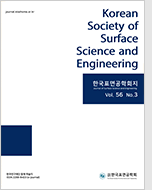
- Past Issues
- e-Submission
-

2021 Impact Factor 1.766
5-Year Impact Factor 1.674
Editorial Office
- +82-2-563-0935
- +82-2-558-2230
- submission@kssse.or.kr
- https://www.kssse.or.kr/

2021 Impact Factor 1.766
5-Year Impact Factor 1.674
The Korean Society of Surface Science and Engineering 2023;56(1):62-68. Published online: Feb, 28, 2023
DOI : 10.5695/JSSE.2023.56.1.62
Silicon (Si) is considered as a promising substitute for the conventional graphite due to its high theoretical specific capacity (3579 mAh/g, Li15Si4) and proper working voltage (~0.3V vs Li+/Li). However, the large volume change of Si during (de)lithiation brings about severe degradation of battery performances, rendering it difficult to be applied in the practical battery directly. As a one feasible candidate of industrial Si anode, silicon monoxide (SiOx) demonstrates great electrochemical stability with its specialized strategy, downsized Si nanocrystallites surrounded by Li+ inactive buffer phase (Li2O and Li4SiO4). Nevertheless, SiOx inherently has the initial irreversible capacity and poor electrical conductivity. To overcome those issues, conformal carbon coating has been performed on SiOx utilizing ethylbenzene as the carbon precursor of chemical vapor deposition (CVD). Through various characterizations, it is confirmed that the carbon is homogeneously coated on the surface of SiOx. Accordingly, the carbon-coated SiOx from CVD using ethylbenzene demonstrates 73% of the first cycle efficiency and great cycle life (88.1% capacity retention at 50th cycle). This work provides a promising synthetic route of the uniform and scalable carbon coating on Si anode for high-energy density.
Keywords Lithium-ion Secondary battery; Silicon Oxide; Carbon Coating; Liquid Precursor.